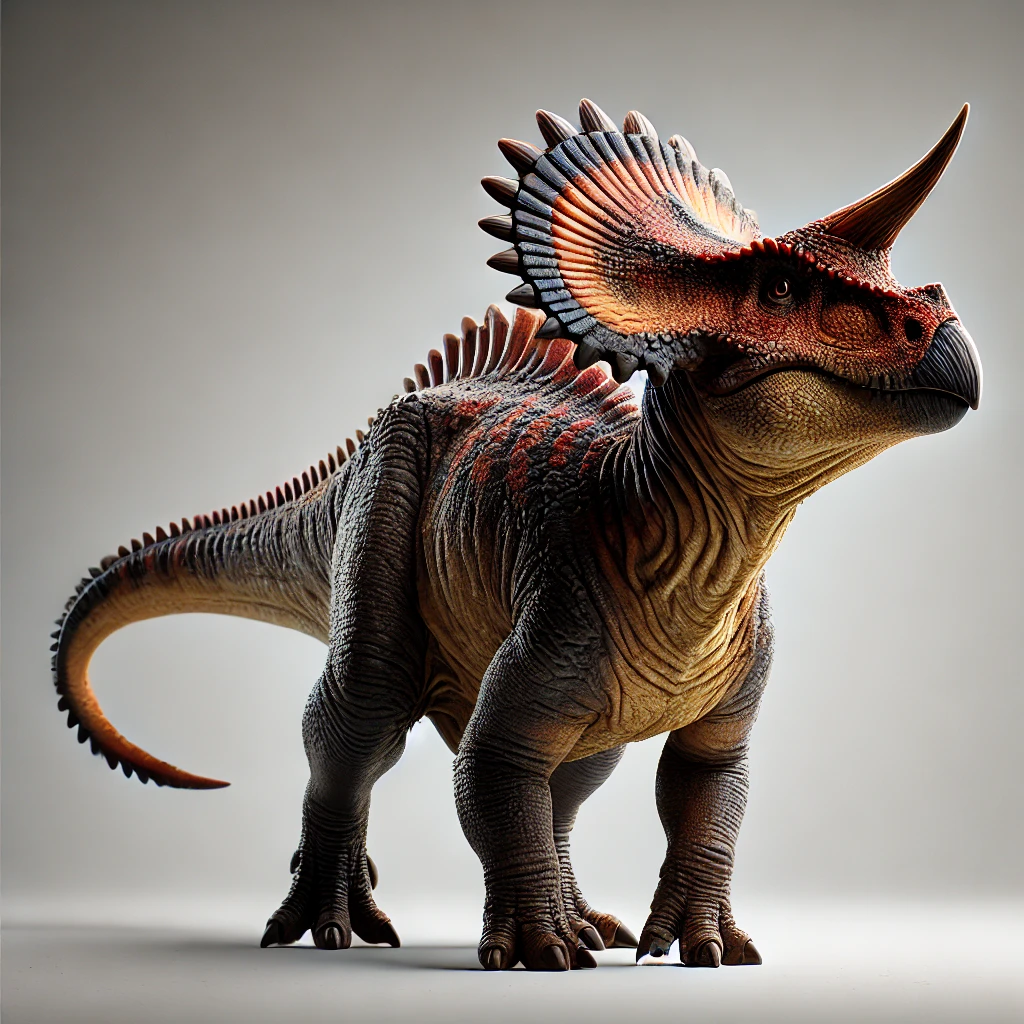Centrosaurus
Pronunciation:
Sen-tro-sore-us
Name Meaning:
“Pointed lizard”
Dinosaur Classification:
- Kingdom: Animalia
- Phylum: Chordata
- Class: Reptilia
- Order: Ornithischia
- Suborder: Ceratopsia
- Family: Ceratopsidae
- Genus: Centrosaurus
- Species: C. apertus
Dinosaur Description:
Centrosaurus was a medium-sized ceratopsid dinosaur that lived during the Late Cretaceous period. It was a member of the horned dinosaurs, characterized by its prominent nasal horn and frill. Centrosaurus reached lengths of approximately 20 feet (6 meters) and had a stocky, quadrupedal body, making it well-suited for defense against predators.
The nasal horn, which was the most distinctive feature of Centrosaurus, was relatively short and curved, while the frill extending from the back of its head was adorned with small, hook-like structures. These adornments may have been used for display purposes or for species recognition within groups. Centrosaurus had a beaked mouth, perfect for cropping vegetation, and a row of cheek teeth for chewing tough plant material.
Centrosaurus lived in large herds, as indicated by the discovery of massive bonebeds containing thousands of individuals. These bonebeds suggest that Centrosaurus may have migrated seasonally and lived in a social structure similar to that of modern-day herbivores. The presence of so many individuals in one area also indicates that these dinosaurs were likely prey for large carnivorous dinosaurs like tyrannosaurs.
The frill of Centrosaurus, though less elaborate than some other ceratopsians, may have played a role in defense or mating displays. Paleontologists have long debated the function of ceratopsian frills, with theories ranging from thermoregulation to protection from predators. However, in Centrosaurus, the simpler structure of the frill suggests it was more likely used for display or social interaction within the herd.
Dinosaur Diet and Behavior:
Centrosaurus was a herbivore, feeding on low-lying plants and shrubs. Its beak and cheek teeth allowed it to effectively crop and chew tough vegetation. The large herds in which Centrosaurus lived suggest it may have migrated in search of food, traveling in groups to reduce the risk of predation.
Dinosaur Size:
Centrosaurus reached lengths of around 20 feet (6 meters).
Dinosaur Weight:
Centrosaurus weighed approximately 2 tons (4,000 lbs).
Fossil Discoveries:
Centrosaurus fossils have been discovered primarily in the Dinosaur Park Formation in Alberta, Canada. One of the most notable finds is the discovery of massive bonebeds containing thousands of Centrosaurus individuals, suggesting that this dinosaur lived in large herds. These bonebeds have provided valuable insights into the social behavior and ecology of Centrosaurus.
What Period Did The Dinosaur Live:
Centrosaurus lived during the Late Cretaceous period, approximately 76 to 75 million years ago.
Notable Facts or Trivia:
– Centrosaurus lived in large herds, making it one of the most social ceratopsians.
– The discovery of massive bonebeds suggests it may have been affected by natural disasters such as flooding.
– Despite its short nasal horn, Centrosaurus may have used its frill and horn for display and social interactions rather than for defense.
– Centrosaurus is named for its distinctive “pointed” nasal horn.
Scientific Significance:
The discovery of Centrosaurus bonebeds has provided valuable information about herd behavior and social structure in ceratopsians. These bonebeds also offer insights into the paleoenvironment of the Late Cretaceous period, showing how large groups of herbivorous dinosaurs interacted with their surroundings and how they may have been impacted by natural events such as floods or droughts.
Extinction & Legacy:
Centrosaurus became extinct around 75 million years ago, possibly due to environmental changes or increased predation. However, its fossils have left a significant legacy in paleontology, helping scientists understand the social behavior and ecological role of ceratopsians. The discovery of Centrosaurus bonebeds has also contributed to studies on mass mortality events in prehistoric times, offering clues to how dinosaur populations may have been affected by natural disasters.
